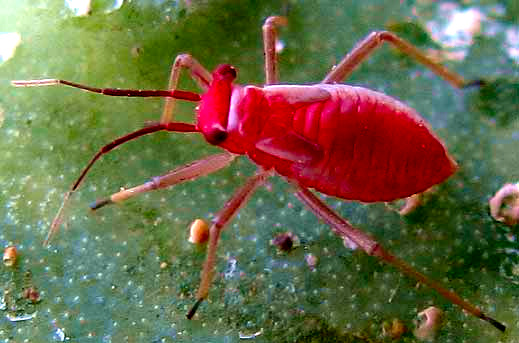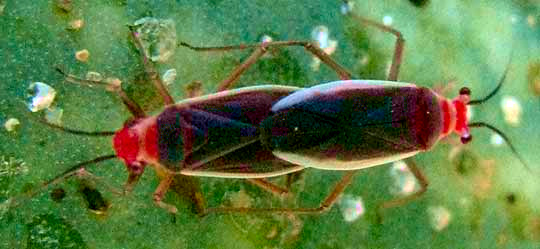Excerpts from Jim Conrad's
Naturalist Newsletter
from the October 28, 2012 Newsletter issued from the valley of the Dry Frio River in northern Uvalde County, southwestern Texas, on the southern border of the Edwards Plateau; elevation ~1750m (~5750 ft); N29.62°, W99.86°; USA
CACTUS BUGS
It seemed that one day the big pricklypear cactus beside the back door was getting along just fine, then the next it was absolutely crawling with hundreds of the red and dark gray-brown, ¼-inch long (6mm) bugs shown below.

This is a member of the True Bug insect order, the Hemiptera -- along with cicadas, aphids and leafhoppers -- so it undergoes incomplete metamorphosis. Therefore, instead of this bug's life cycle consisting of egg-larva-pupa-adult, it is egg-nymph-adult. Nymphs are like adults, except that their wings aren't developed and they're smaller. Plenty of this bug's nymphs ranged the cactus along with the grown-ups. That's a nymph below:

In that image you can see the nymph's future wings budding behind its head.
Besides nymphs and individual adults, some adult bugs were busy making more of their numbers, as shown at shown below:

Volunteer bug identifier Bea in Ontario had no problems finding the name for this one. It's the Cactus Bug, HESPEROLOBOPS GELASTOPS, occurring only on pricklypear cacti (genus Opuntia), and found mostly in cactus-rich Mexico, but also in the US, in Texas cactus country. In Mexico where edible Nopal Cactus, which is a spineless pricklypear, is grown on a large scale, Cactus Bugs can be very destructive.